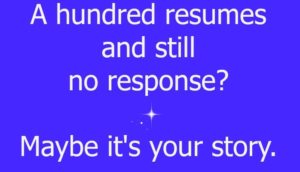
In today’s environment, one of the most difficult things job search candidates face is the ability to stand out. Hours are spent crafting an ideal cover letter, with all the proof in the world of a perfect fit for the position. The resume of experience includes a nod to every single bullet point listed on that posting, justifying the expectation for an interview.
Companies and head hunters alike expect that resumes will be received electronically, where your information comes to them through a black hole, with little or no human contact. You follow the instructions perfectly. But then you wait, and wait, and wait, hoping for any kind of response.
What many candidates do not realize is that, with most companies or recruiters, your resume gets very little human attention during the first stages of hiring.
In fact, even the new titles being adopted for many HR & recruiting firms reflect that distancing of the human touch. Popular titles such as Talent Management, Member Services, Employee Onboarding and Talent Acquisition all seem to embrace the more technologically driven profile of the hiring process.
In the application process, the highlights of of a candidate’s experiences are typically forced into a generic application format, robbing the resume of every iota of creativity. All in the name of “efficiency.”
Even the salutation in the cover letter has become somewhat of a game in the process. Recruiters and HR personnel alike are diligent about protecting the name of the hiring professional, sometimes to an extreme. And with many head hunters, some resumes won’t make the cut simply because they weren’t addressed “appropriately.”
A candidate’s ability to obtain the correct addressee’s name is often interpreted as an indication of how “committed” candidates truly are, and how willing they are to “go the extra mile” in general.
Once resumes are received, most are put through a “resume optimization” process, which is basically pattern recognition software that scans the resume for specific words or phrases that coincide with the job description. The purpose of the scanning method at this point is to cut down the number of applicants to a more manageable level.
Cut or not, most prospects are not even given the consideration of an acknowledgement that their resume was received at all. Sadly, this has become an acceptable norm.
Making the first cut does not mean you made it to the final round.
Once the initial scanning elimination phase is complete, the piles are further reduced to a handful of those who managed to stand out. Typically this stage relies heavily on filters searching for words describing the skill set of the candidates. Only then are interviews set up, and sometimes this can be several weeks after the initial resumes were received.
So what do you need to do, as a potential candidate, to get the attention of the hiring professionals and move into the final round of cuts?
Here are some tips to help you craft a stand-out resume and become one of the handful selected for the interview.
- Start with a resume that will TELL YOUR STORY. Who you are, not just what you have done in your career, and where you want to go. Build your story from a point of impact.
- Include YOUR BEST SKILLS & QUALITIES in a way that addresses the company’s needs. Imagine what key words the hiring professional would enter in a search for the right candidate.
- Highlight your position’s FUNCTION and your ACCOMPLISHMENTS. Don’t just list the job duties; underscore your role in the department as it related to the overall company.
Understand that your resume is your story, your calling card, your launch pad.
Make it speak to who you are and why you are the right person for the job. Craft your corresponding cover letter addressing your best skills, and draw the parallels to the position requirements. And, most of all, highlight the functionality of your experiences. Answer the question, “Why am I the best candidate for the job?”
button